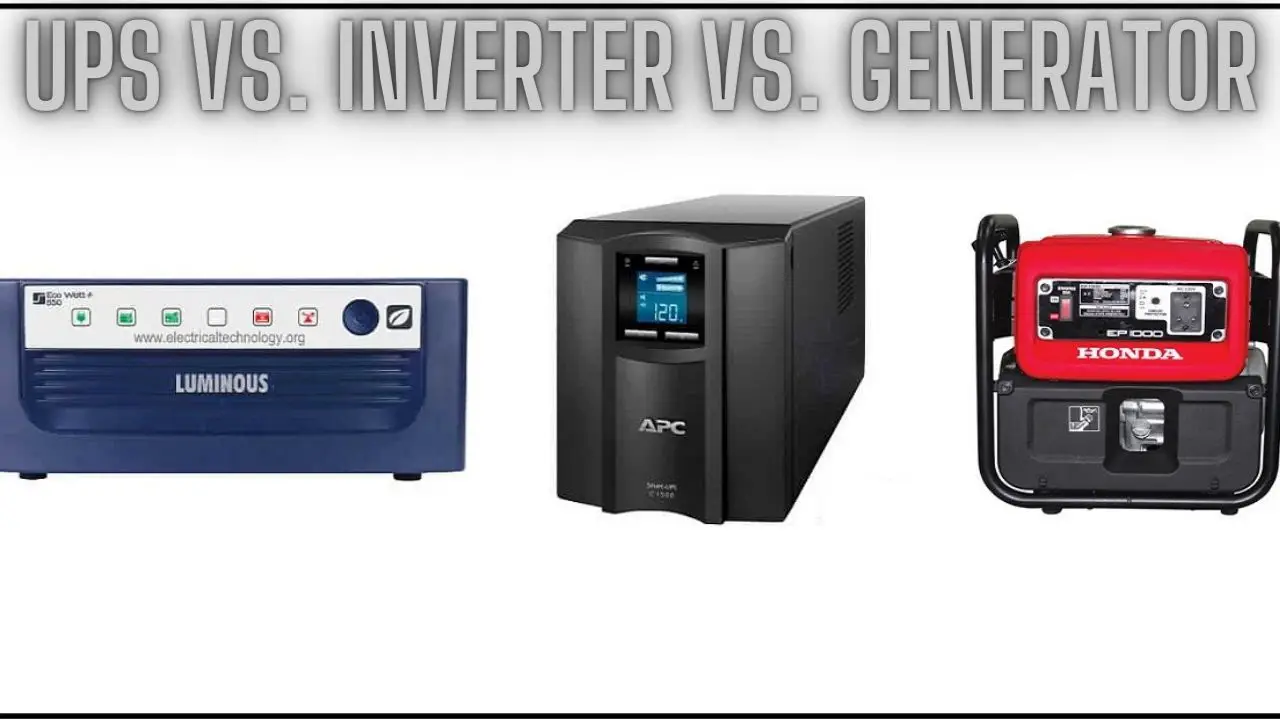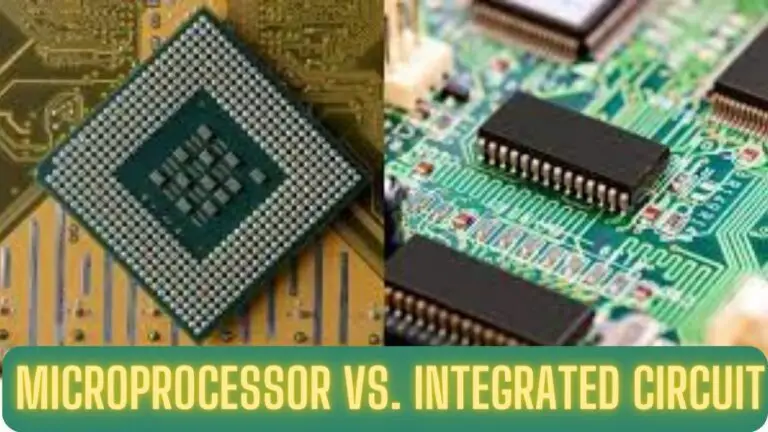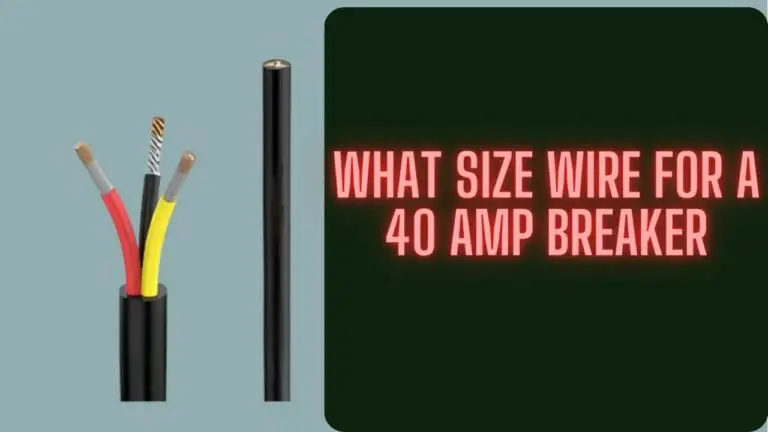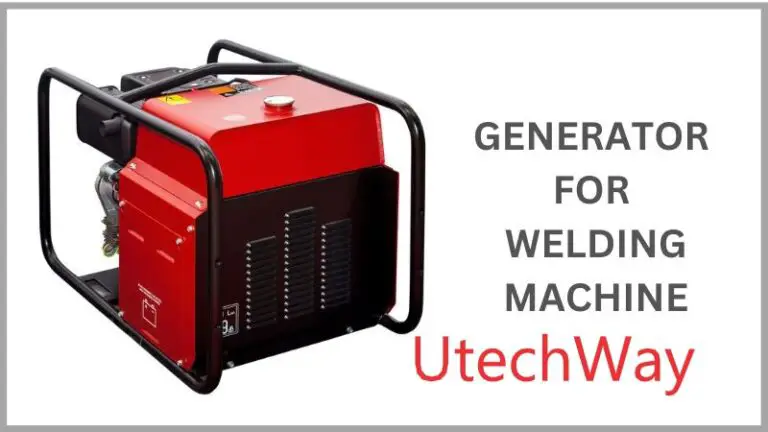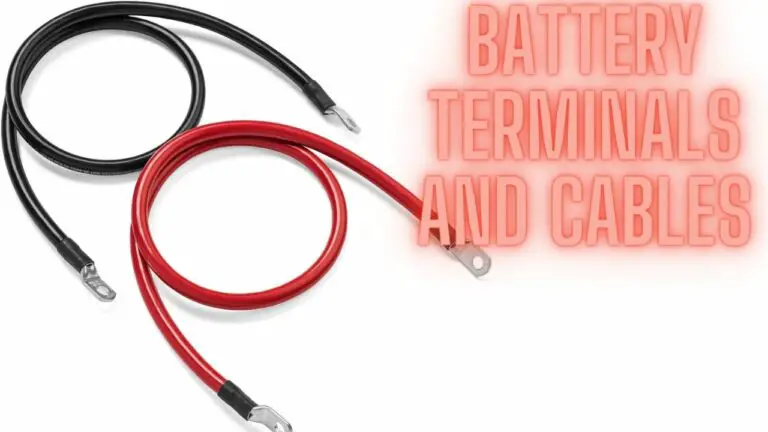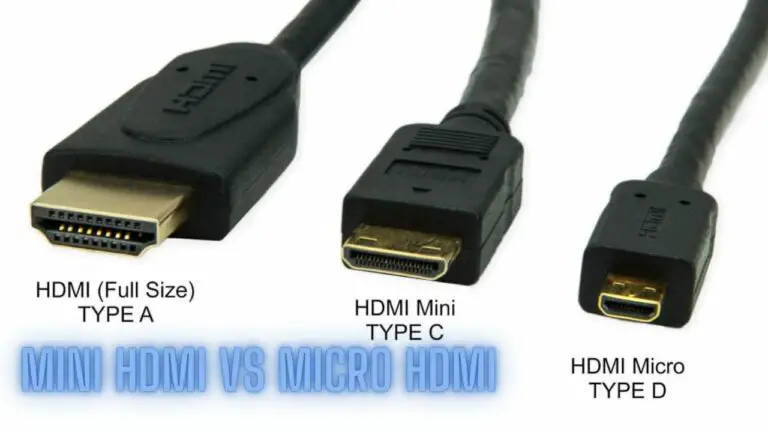Uninterruptible Power Supply (UPS) vs. Inverter vs. Generator
Introduction
In today’s interconnected world, uninterrupted access to electrical power is essential for both residential and commercial applications. However, power outages, voltage fluctuations, and grid failures are inevitable occurrences that can disrupt operations, damage electronic devices, and inconvenience individuals. To mitigate the impact of such events, various backup power solutions are available, including Uninterruptible Power Supplies (UPS), inverters, and generators.
Each of these systems serves the common purpose of providing backup power during mains power failures, but they differ in terms of technology, functionality, and suitability for different applications. Understanding the distinctions between UPS, inverters, and generators is crucial for selecting the most appropriate solution based on specific requirements, budget constraints, and environmental considerations.
In this comprehensive comparison, we will delve into the fundamental aspects of UPS, inverters, and generators, exploring their operation, components, performance characteristics, and application suitability. By examining the pros and cons of each system and considering factors such as power capacity, runtime, efficiency, and maintenance requirements, readers will gain valuable insights into choosing the optimal backup power solution for their needs.
Basic Functionality
Uninterruptible Power Supply (UPS):
A UPS is a device that provides emergency power to a load when the input power source, typically mains power, fails. It consists of a battery backup system, charging circuitry, and an inverter. During normal operation, the UPS continuously charges its internal battery while also providing power to connected devices from the mains power source. When the mains power fails or experiences disruptions such as voltage fluctuations, the UPS switches to battery power almost instantly, ensuring uninterrupted power supply to the connected devices. UPS systems are commonly used to protect critical equipment such as computers, servers, networking devices, and telecommunications equipment from power outages and voltage fluctuations.
Inverter:
An inverter is a standalone device or part of a larger power backup system that converts DC (Direct Current) power from a battery or other DC power source into AC (Alternating Current) power suitable for powering household appliances, electronic devices, and other equipment. Inverters are commonly used in off-grid or standalone power systems, such as solar or wind power systems, where they convert DC power generated by renewable energy sources into AC power for use in homes, cabins, RVs, and remote locations. Inverters may also be used in conjunction with batteries to provide backup power during mains power outages, although they typically require a separate charging system to maintain battery charge.
Generator:
A generator is a device that converts mechanical energy into electrical energy using an internal combustion engine fueled by diesel, gasoline, natural gas, or propane. Generators are typically used as standalone power sources or backup power systems to provide electricity during mains power outages or in areas where grid power is unavailable. When the mains power fails, an automatic transfer switch (ATS) or manual switch transfers the electrical load from the mains power source to the generator. Generators can provide continuous power for extended periods, making them suitable for powering homes, businesses, construction sites, and events.
In summary, UPS systems provide immediate backup power using batteries, inverters convert DC power into AC power for various applications, and generators produce electrical power using internal combustion engines, offering reliable backup power solutions for different scenarios and requirements.
Components and Operation
Uninterruptible Power Supply (UPS):
- Battery: The UPS battery is the primary component responsible for storing electrical energy during normal operation. It typically consists of one or more sealed lead-acid batteries or lithium-ion batteries.
- Rectifier/Charger: The rectifier or charger is responsible for converting AC power from the mains supply into DC power to charge the UPS battery. It ensures that the battery remains fully charged and ready to provide backup power when needed.
- Inverter: The inverter is a critical component of the UPS system responsible for converting DC power from the battery into AC power during mains power failures. It ensures a seamless transition from mains power to battery power, providing uninterrupted power to connected devices.
- Transfer Switch: The transfer switch automatically detects mains power failures and switches the electrical load from the mains power source to the UPS battery or inverter. It ensures a smooth transition without interruption to the connected devices.
- Control Panel: The control panel or interface provides users with information about the UPS status, battery level, load capacity, and other critical parameters. It may include LED indicators, LCD displays, and control buttons for monitoring and managing the UPS system.
Inverter:
- DC Power Source: The DC power source provides the input power to the inverter, typically from batteries, solar panels, wind turbines, or other DC power sources.
- Inverter Circuit: The inverter circuit is the core component of the inverter system responsible for converting DC power into AC power. It consists of power electronics components such as transistors, capacitors, and diodes that switch DC voltage to produce an alternating voltage waveform.
- Control System: The control system regulates the operation of the inverter, ensuring efficient power conversion and protection against overvoltage, undervoltage, short circuits, and other faults. It may include microcontrollers, sensors, and feedback mechanisms for monitoring and adjusting the inverter’s output.
Generator:
- Internal Combustion Engine: The internal combustion engine is the primary component of the generator responsible for converting fuel (e.g., diesel, gasoline, natural gas) into mechanical energy through combustion. It drives the generator’s alternator to produce electrical power.
- Alternator: The alternator, also known as the generator head, is a rotating machine that converts mechanical energy from the engine into electrical energy. It consists of a stator, rotor, and electromagnetic coils that generate alternating current (AC) electricity when rotated by the engine.
- Fuel System: The fuel system includes components such as fuel tanks, fuel pumps, fuel filters, and fuel injectors responsible for delivering fuel to the engine for combustion.
- Cooling System: The cooling system helps regulate the temperature of the generator’s engine and alternator to prevent overheating and ensure optimal performance. It typically includes components such as radiators, cooling fans, and coolant pumps.
- Control Panel: The control panel provides operators with information about the generator’s status, fuel level, engine temperature, output voltage, and other critical parameters. It may include gauges, switches, indicators, and digital displays for monitoring and controlling the generator’s operation.
In summary, UPS systems consist of batteries, chargers, inverters, and transfer switches to provide immediate backup power. Inverters convert DC power from batteries or other sources into AC power, while generators utilize internal combustion engines and alternators to produce electrical power from fuel. Each system has specific components and operation principles tailored to its intended application and requirements.
Power Capacity and Output
Uninterruptible Power Supply (UPS):
- UPS systems are available in a wide range of power capacities, from small units suitable for powering individual computers or home electronics to large systems capable of supporting entire data centers or critical infrastructure.
- The power output of a UPS is typically rated in volt-amperes (VA) or watts (W). VA rating represents the apparent power capacity of the UPS, while the watt rating indicates the effective power output available to connected devices.
- UPS systems may have different power output configurations, including single-phase output for residential and small commercial applications or three-phase output for larger installations.
Inverter:
- Inverters are available in various power capacities to suit different applications, ranging from small portable inverters for camping or outdoor use to larger units for powering homes, businesses, or off-grid installations.
- The power output of an inverter is typically rated in watts (W) or kilowatts (kW) and represents the maximum continuous power that the inverter can deliver to connected loads.
- Inverters may have single-phase or three-phase output configurations depending on the intended application and requirements.
Generator:
- Generators are available in a wide range of power capacities, from small portable units suitable for powering individual appliances or tools to large stationary units capable of supplying backup power to entire buildings or facilities.
- The power output of a generator is typically rated in kilowatts (kW) or megawatts (MW) and represents the maximum electrical power that the generator can produce under rated conditions.
- Generators may have single-phase or three-phase output configurations, depending on the application and electrical requirements of connected loads.
In summary, UPS systems, inverters, and generators are available in various power capacities to suit different applications and requirements. UPS systems and inverters are typically used for providing backup power to critical loads during mains power failures, while generators are used as standalone or backup power sources for a wide range of applications, including residential, commercial, and industrial settings. Understanding the power capacity and output characteristics of each system is essential for selecting the most suitable solution for specific needs and requirements.
Backup Time and Runtime
Uninterruptible Power Supply (UPS):
- The backup time or runtime of a UPS system depends on several factors, including the capacity of the UPS battery, the power load connected to the UPS, and the efficiency of the UPS inverter.
- UPS systems are typically designed to provide backup power for relatively short durations, ranging from a few minutes to several hours, depending on the size and capacity of the UPS battery.
- The backup time of a UPS is calculated based on the power load connected to the UPS and the capacity of the UPS battery. Higher power loads will deplete the battery more quickly, reducing the backup time available.
Inverter:
- The backup time or runtime of an inverter system depends on the capacity of the battery bank connected to the inverter, the power load connected to the inverter, and the efficiency of the inverter.
- Inverter systems can provide backup power for varying durations, depending on the size and capacity of the battery bank. Larger battery banks can store more energy and provide longer backup times.
- The backup time of an inverter is calculated based on the power load connected to the inverter, the capacity of the battery bank, and the discharge rate of the batteries. Higher power loads or faster discharge rates will deplete the battery more quickly, reducing the backup time available.
Generator:
- The backup time or runtime of a generator depends on several factors, including the size and capacity of the generator, the fuel tank capacity, and the fuel consumption rate of the generator.
- Generators can provide backup power for extended durations, ranging from a few hours to several days, depending on the size of the fuel tank and the fuel consumption rate of the generator.
- The backup time of a generator is calculated based on the fuel tank capacity, the fuel consumption rate of the generator, and the load connected to the generator. Higher power loads or higher fuel consumption rates will deplete the fuel tank more quickly, reducing the backup time available.
In summary, the backup time or runtime of UPS systems, inverters, and generators depends on various factors, including the capacity of the battery or fuel tank, the power load connected to the system, and the efficiency of the system components. Understanding the backup time characteristics of each system is essential for ensuring reliable backup power supply during mains power outages or disruptions.
Response Time and Switching
Uninterruptible Power Supply (UPS):
- UPS systems offer rapid response times, typically in the range of milliseconds (ms) to seconds, ensuring seamless transition from mains power to battery power during power outages.
- UPS systems employ automatic transfer switches (ATS) or static switches to facilitate fast switching between mains power and battery power without interruption to connected devices.
- The transfer switch in a UPS detects mains power failures or voltage fluctuations and automatically switches the electrical load from the mains power source to the UPS battery or inverter. This process occurs almost instantly, minimizing downtime and ensuring continuous power supply to critical equipment.
Inverter:
- Inverters also provide rapid response times, typically within milliseconds (ms) to seconds, when switching between mains power and battery power during power outages.
- Inverter systems may use automatic transfer switches (ATS) or relays to facilitate seamless transition from mains power to battery power without interruption to connected devices.
- The transfer switch in an inverter detects mains power failures or voltage fluctuations and automatically switches the electrical load from the mains power source to the inverter’s battery or DC power source. This process occurs quickly, ensuring uninterrupted power supply to connected loads.
Generator:
- Generators typically have longer response times compared to UPS systems and inverters, ranging from seconds to minutes, depending on factors such as startup time, engine warm-up time, and automatic transfer switch (ATS) activation time.
- When mains power fails, an automatic transfer switch (ATS) or manual switch transfers the electrical load from the mains power source to the generator. The generator then starts up, stabilizes, and begins supplying power to the connected loads.
- The response time of a generator depends on the type of generator (e.g., standby, portable), the size and capacity of the generator, and the speed of the engine startup process. In some cases, generators may require manual intervention or startup procedures before providing backup power.
In summary, UPS systems and inverters offer rapid response times and seamless switching between mains power and battery power, typically within milliseconds to seconds. Generators have longer response times, ranging from seconds to minutes, depending on startup and activation procedures. Understanding the response time and switching characteristics of each system is essential for ensuring uninterrupted power supply during mains power outages or disruptions.
Efficiency and Energy Consumption
Uninterruptible Power Supply (UPS):
- UPS systems vary in efficiency depending on factors such as design, load level, and battery type. Modern UPS systems typically have high efficiency ratings, ranging from 85% to 95% or higher.
- Efficiency is highest when the UPS is operating at or near its rated load capacity. Lower loads may result in decreased efficiency due to factors such as transformer losses and idle power consumption.
- UPS systems consume energy continuously to maintain battery charge and standby power. Energy consumption depends on factors such as battery size, charging frequency, and standby power losses.
Inverter:
- Inverters vary in efficiency depending on factors such as design, load level, and inverter type (e.g., pure sine wave, modified sine wave). High-quality inverters can achieve efficiency ratings of 90% or higher.
- Inverters operate most efficiently when operating at or near their rated load capacity. Higher loads may result in increased efficiency due to reduced losses and improved power conversion.
- Inverters consume energy only when supplying power to connected loads. Standby power consumption is minimal compared to UPS systems, as inverters do not need to maintain battery charge during standby operation.
Generator:
- Generators vary in efficiency depending on factors such as engine type, size, and operating conditions. Diesel generators typically have higher efficiency ratings compared to gasoline or natural gas generators.
- Generator efficiency is highest when operating at or near their rated load capacity. Oversizing a generator or operating at light loads may result in decreased efficiency and increased fuel consumption.
- Generators consume fuel continuously during operation, with fuel consumption rates varying depending on factors such as load demand, engine efficiency, and fuel type.
In summary, UPS systems, inverters, and generators have different efficiency characteristics and energy consumption patterns. UPS systems and inverters typically have high efficiency ratings, with UPS systems consuming energy continuously to maintain battery charge and standby power. In contrast, inverters only consume energy when supplying power to connected loads. Generators have varying efficiency depending on operating conditions, with fuel consumption rates dependent on factors such as load demand and engine efficiency. Understanding the efficiency and energy consumption characteristics of each system is essential for optimizing energy usage and minimizing operating costs.
Noise and Environmental Impact
Uninterruptible Power Supply (UPS):
- UPS systems are generally quiet during operation, producing minimal noise as they primarily rely on batteries and inverters to provide backup power.
- UPS systems have a minimal environmental impact as they do not emit exhaust gases or pollutants during normal operation. However, they do require batteries which need proper disposal at the end of their life cycle.
Inverter:
- Inverters are typically quiet during operation, especially modern high-quality inverters. They produce minimal noise as they convert DC power to AC power using electronic components.
- Inverters have a low environmental impact, especially in renewable energy applications where they are often used with solar panels or wind turbines to generate clean electricity. However, they do require batteries for energy storage which need proper disposal at the end of their life cycle.
Generator:
- Generators produce noise during operation due to the combustion of fuel in the engine and the mechanical operation of the generator. The noise level can vary depending on factors such as generator size, engine type, and enclosure design.
- Generators have a higher environmental impact compared to UPS systems and inverters as they emit exhaust gases, noise, and pollutants during operation. Diesel generators, in particular, emit nitrogen oxides (NOx), particulate matter (PM), and carbon dioxide (CO2).
- However, modern generator designs incorporate technologies such as catalytic converters and mufflers to reduce emissions and noise levels. Additionally, using cleaner fuels such as natural gas or propane can help mitigate the environmental impact of generators.
In summary, UPS systems and inverters have minimal noise levels and environmental impact compared to generators. UPS systems rely on batteries and inverters for backup power and do not produce emissions during operation. Inverters are often used with renewable energy sources, further reducing their environmental impact. Generators, on the other hand, produce noise and emissions during operation, although modern designs incorporate technologies to reduce their environmental footprint. Proper maintenance and fuel management are essential to minimize the environmental impact of generators.
Maintenance Requirements
Uninterruptible Power Supply (UPS):
- Battery Maintenance: Regularly inspect and maintain UPS batteries to ensure proper operation and maximum lifespan. This includes checking battery terminals for corrosion, testing battery voltage and capacity, and replacing batteries as needed.
- Airflow and Cooling: Keep UPS units clean and ensure adequate airflow for cooling to prevent overheating. Clean or replace air filters as recommended by the manufacturer.
- Software Updates: Regularly update UPS firmware and management software to ensure compatibility with connected devices and to address any security vulnerabilities or performance issues.
- Load Testing: Periodically perform load testing to verify UPS performance under simulated power outage conditions. This helps identify potential issues and ensures that the UPS can handle the required load during actual power outages.
- Visual Inspection: Conduct visual inspections of UPS components, including circuit boards, capacitors, and fans, to check for signs of wear, damage, or overheating. Address any issues promptly to prevent equipment failure.
Inverter:
- Battery Maintenance: Similar to UPS systems, inverters require regular battery maintenance to ensure optimal performance and longevity. This includes checking battery terminals, monitoring battery voltage, and replacing batteries as needed.
- Cooling System: Inspect and clean inverter cooling fans or heat sinks to ensure efficient heat dissipation and prevent overheating. Replace any worn or damaged components as necessary.
- Software Updates: If applicable, update inverter firmware and management software to ensure compatibility with connected devices and to address any software bugs or security vulnerabilities.
- Electrical Connections: Periodically check electrical connections, including terminals, cables, and fuses, for tightness and corrosion. Loose connections can cause voltage drops and affect inverter performance.
- Load Testing: Perform load testing to verify inverter performance under various load conditions and ensure that it can handle the required power loads without overheating or failure.
Generator:
- Fuel System: Regularly inspect and maintain the generator’s fuel system, including fuel tanks, filters, lines, and injectors, to ensure proper fuel delivery and prevent fuel contamination or blockages.
- Cooling System: Monitor and maintain the generator’s cooling system, including coolant levels, hoses, pumps, and radiators, to prevent overheating and ensure efficient engine operation.
- Oil and Fluids: Check and replace engine oil, coolant, and other fluids according to the manufacturer’s recommendations to maintain optimal engine performance and longevity.
- Air and Exhaust System: Inspect and clean air filters, intake vents, and exhaust systems to ensure proper airflow and combustion efficiency. Replace filters and remove any obstructions as needed.
- Electrical System: Test and inspect electrical components, including wiring, switches, relays, and circuit breakers, to ensure proper operation and electrical safety. Address any issues promptly to prevent electrical failures or malfunctions.
In summary, maintenance requirements for UPS systems, inverters, and generators include battery maintenance, cooling system maintenance, software updates, electrical inspections, and load testing. Regular maintenance and proactive monitoring are essential to ensure reliable performance, prevent downtime, and prolong the lifespan of backup power systems.
Cost Considerations
Uninterruptible Power Supply (UPS):
- Initial Investment: UPS systems typically have a moderate to high initial investment cost, depending on factors such as capacity, features, and brand. Higher capacity UPS units with longer backup times and advanced features such as remote monitoring and management tend to be more expensive.
- Operating Costs: UPS systems have relatively low operating costs compared to generators, as they do not require fuel or ongoing maintenance such as oil changes or filter replacements. However, UPS batteries have a limited lifespan and will need to be replaced periodically, which can incur additional costs.
Inverter:
- Initial Investment: Inverters have a wide range of initial investment costs depending on factors such as capacity, efficiency, and features. Portable or small-scale inverters for residential use may have lower upfront costs, while larger or higher-capacity inverters for commercial or off-grid applications can be more expensive.
- Operating Costs: Inverters have relatively low operating costs compared to generators, as they do not require fuel or ongoing maintenance. However, inverters may require periodic battery replacements, especially in off-grid or backup power applications, which can contribute to long-term operating costs.
Generator:
- Initial Investment: Generators typically have a higher initial investment cost compared to UPS systems and inverters, especially for larger or higher-capacity units. Factors such as fuel type, power output, brand, and features (e.g., automatic start, remote monitoring) can influence the upfront cost of a generator.
- Operating Costs: Generators have higher operating costs compared to UPS systems and inverters, as they require fuel to operate. Fuel costs can vary depending on factors such as fuel type, fuel price fluctuations, and generator runtime. Additionally, generators require ongoing maintenance such as fuel and oil changes, filter replacements, and periodic inspections, which can contribute to long-term operating costs.
In summary, cost considerations for UPS systems, inverters, and generators include initial investment costs, operating costs, and long-term maintenance expenses. UPS systems have moderate to high initial costs but lower operating costs compared to generators. Inverters have a wide range of initial costs and relatively low operating costs, while generators have higher initial and operating costs due to fuel consumption and maintenance requirements. Understanding the total cost of ownership and evaluating factors such as efficiency, reliability, and application suitability is essential for selecting the most cost-effective backup power solution for specific needs and requirements.
Application and Suitability
Uninterruptible Power Supply (UPS):
- Critical Infrastructure: UPS systems are well-suited for protecting critical infrastructure, such as data centers, telecommunications facilities, and healthcare facilities, where uninterrupted power supply is essential to prevent data loss, equipment damage, and service interruptions.
- Computers and Electronics: UPS systems are commonly used to provide backup power for computers, servers, networking equipment, and other sensitive electronics in homes, offices, and businesses to prevent data loss and ensure continuity of operations during power outages.
- Sensitive Equipment: UPS systems are ideal for protecting sensitive equipment, such as medical devices, laboratory instruments, and manufacturing equipment, from power disturbances such as voltage fluctuations, surges, and brownouts.
Inverter:
- Off-Grid Power: Inverters are well-suited for off-grid power applications, such as remote cabins, RVs, boats, and mobile homes, where access to mains power is limited or unavailable. Inverters can convert DC power from batteries, solar panels, or wind turbines into AC power for powering appliances, lights, and electronics.
- Renewable Energy Systems: Inverters are commonly used in conjunction with renewable energy sources, such as solar panels and wind turbines, to convert DC power into usable AC power for residential, commercial, and industrial applications. Inverters help maximize the efficiency and reliability of renewable energy systems by converting variable DC output into stable AC power for use in homes and businesses.
- Backup Power: Inverters can provide backup power for homes, offices, and businesses during mains power outages when used with battery banks or backup generators. They offer a reliable and cost-effective solution for maintaining essential power supply during emergencies.
Generator:
- Emergency Backup Power: Generators are ideal for providing emergency backup power during prolonged mains power outages, natural disasters, or other emergencies. They can supply continuous power to homes, businesses, hospitals, and critical infrastructure until mains power is restored.
- Construction and Events: Generators are commonly used in construction sites, outdoor events, and remote locations where access to mains power is limited or unavailable. They provide reliable power for tools, equipment, lighting, and other electrical loads, enabling construction activities and event operations to proceed smoothly.
- Industrial and Commercial Applications: Generators are widely used in industrial and commercial settings, such as manufacturing plants, warehouses, and data centers, where uninterrupted power supply is critical for maintaining production processes, equipment operation, and business continuity.
In summary, UPS systems are ideal for protecting critical infrastructure, computers, and sensitive equipment from power disturbances. Inverters are well-suited for off-grid power, renewable energy systems, and backup power applications. Generators are best suited for emergency backup power, construction sites, events, and industrial/commercial applications where continuous power supply is essential. Understanding the specific requirements and constraints of each application is crucial for selecting the most suitable backup power solution.
Reliability and Durability
Uninterruptible Power Supply (UPS):
- Reliability: UPS systems are highly reliable for providing uninterrupted power supply during mains power outages and disturbances. They offer instantaneous switchover to battery power, ensuring continuous operation of connected equipment without interruption.
- Durability: UPS systems are designed to withstand frequent use and provide long-term reliability. High-quality UPS units are built with durable components and undergo rigorous testing to ensure performance under various conditions.
Inverter:
- Reliability: Inverters are generally reliable for converting DC power into AC power and providing backup power during mains power outages. However, their reliability may depend on factors such as the quality of components, design, and maintenance practices.
- Durability: Inverters vary in durability depending on the brand, model, and construction. High-quality inverters are built with durable components and feature robust designs to withstand harsh environmental conditions and frequent use.
Generator:
- Reliability: Generators are known for their high reliability and robustness in providing backup power during mains power outages. They offer continuous power supply for extended durations and are widely used in critical applications where uninterrupted power is essential.
- Durability: Generators are built to withstand heavy-duty use and harsh environmental conditions. They are constructed with durable materials and feature robust designs to ensure long-term durability and reliability.
In summary, UPS systems, inverters, and generators are all reliable backup power solutions, but their reliability and durability may vary depending on factors such as brand, model, quality of components, and maintenance practices. UPS systems offer instantaneous switchover to battery power and are highly reliable for protecting critical equipment from power disturbances. Inverters are reliable for converting DC power to AC power and providing backup power during mains power outages, while generators are known for their durability and robustness in providing continuous power supply for extended durations. Regular maintenance and proper usage are essential for maximizing the reliability and durability of backup power systems.
Pros and Cons
Uninterruptible Power Supply (UPS):
Pros:
- Provides immediate backup power during mains power outages, ensuring uninterrupted operation of critical equipment.
- Protects sensitive electronics and equipment from power disturbances such as voltage fluctuations, surges, and brownouts.
- Offers automatic switchover to battery power, minimizing downtime and preventing data loss or equipment damage.
- Available in various capacities and configurations to suit different applications and requirements.
- Can be integrated with software for remote monitoring, management, and shutdown of connected devices.
Cons:
- Limited backup time: UPS systems typically provide backup power for a few minutes to several hours, depending on battery capacity and load.
- Requires periodic battery maintenance and replacement to ensure optimal performance and reliability.
- Initial investment cost can be higher compared to other backup power solutions.
- Efficiency may decrease at lower load levels, leading to higher energy consumption and operating costs.
- May require additional space for installation, especially for larger UPS units with extended runtime capabilities.
Inverter:
Pros:
- Offers flexible backup power solutions for off-grid, renewable energy, and backup power applications.
- Converts DC power from batteries, solar panels, or wind turbines into AC power for powering appliances, electronics, and other electrical loads.
- Can be used in conjunction with renewable energy sources to maximize energy efficiency and reduce reliance on grid power.
- Provides silent operation and minimal environmental impact compared to generators.
- Available in various sizes and configurations to suit different power requirements and applications.
Cons:
- Limited backup time: Inverters rely on battery banks for backup power, which may have limited capacity and require periodic maintenance and replacement.
- Initial investment cost can be higher compared to UPS systems for similar power capacities and features.
- Efficiency may vary depending on load conditions, battery type, and inverter design.
- May require additional components such as charge controllers, battery monitors, and wiring for proper installation and operation.
- Reliability may depend on battery quality, maintenance practices, and environmental factors.
Generator:
Pros:
- Provides continuous power supply for extended durations during mains power outages, emergencies, or remote operations.
- Offers high power output and versatility for various applications, including residential, commercial, industrial, and outdoor use.
- Available in different fuel types (e.g., diesel, gasoline, natural gas, propane) to suit specific requirements and preferences.
- Can be integrated with automatic transfer switches (ATS) for seamless switchover to backup power during mains power outages.
- Offers reliable operation and robust construction for long-term durability and performance.
Cons:
- Generates noise and emissions during operation, requiring proper placement and ventilation to minimize impact on surrounding areas.
- Requires regular maintenance, including fuel and oil changes, filter replacements, and periodic inspections, to ensure optimal performance and reliability.
- Initial investment cost can be higher compared to UPS systems and inverters, especially for larger or higher-capacity units.
- Fuel consumption and operating costs can be significant, especially for high-power generators or prolonged use.
- Startup time and response may be slower compared to UPS systems and inverters, requiring manual intervention or activation during power outages.
FAQs
1. What is the primary difference between a UPS, inverter, and generator?
- UPS: A UPS provides instant backup power during mains power outages by using batteries or capacitors to supply power to connected devices. It ensures uninterrupted operation of critical equipment and protects against power disturbances.
- Inverter: An inverter converts DC power from batteries, solar panels, or wind turbines into AC power for use in homes, businesses, or off-grid applications. It provides backup power during outages and is often used in conjunction with renewable energy sources.
- Generator: A generator produces electrical power by using an internal combustion engine to drive an alternator. It provides continuous power supply for extended durations and is commonly used for emergency backup power, construction sites, events, and industrial applications.
2. Which option is best for residential backup power needs?
- For residential backup power needs, the choice depends on factors such as power requirements, duration of backup needed, noise considerations, and environmental impact. UPS systems are suitable for providing instant backup power to protect sensitive electronics and equipment, while generators offer continuous power supply for extended durations during prolonged outages. Inverters are ideal for off-grid and renewable energy applications, providing flexible backup power solutions with minimal environmental impact.
3. How do I determine the right size and capacity for my backup power solution?
- The size and capacity of your backup power solution depend on factors such as the power requirements of connected devices, the duration of backup needed, and any specific requirements or constraints of your application. Consult with a qualified electrician or backup power specialist to assess your needs and recommend the appropriate UPS, inverter, or generator size and capacity.
4. Are there any safety considerations I should be aware of when using backup power solutions?
- Safety is paramount when using backup power solutions. Follow all manufacturer’s instructions and guidelines for installation, operation, and maintenance. Ensure proper ventilation, grounding, and electrical connections to prevent overheating, electrical shocks, or fire hazards. Regularly inspect and test backup power systems to ensure they are functioning correctly and address any issues promptly.
5. Can backup power solutions be used in conjunction with renewable energy sources such as solar panels or wind turbines?
- Yes, both inverters and generators can be used in conjunction with renewable energy sources such as solar panels or wind turbines to provide backup power or supplement grid power. Inverters are commonly used to convert DC power from solar panels or wind turbines into AC power for use in homes, businesses, or off-grid applications. Generators can be used as backup power sources or to supplement renewable energy systems during periods of low renewable energy production.
6. How do I maintain and care for my backup power solution to ensure optimal performance and reliability?
- Regular maintenance and care are essential for ensuring optimal performance and reliability of backup power solutions. Follow manufacturer’s guidelines for maintenance tasks such as battery checks, cleaning, and inspections. Test backup power systems periodically to verify proper operation and address any issues promptly. Keep backup power systems clean, well-ventilated, and free from obstructions to ensure efficient operation and longevity.
Conclusion
Selecting the right power backup solution involves considering the specific needs of your home, office, or business. UPS, inverters, and generators each have their strengths and applications. For short-term protection of sensitive equipment, a UPS is ideal. Inverters are suitable for providing backup power to essential devices in homes and offices. Generators excel in providing continuous power for extended durations and are often essential for businesses, data centers, and locations with frequent or prolonged outages.
When making a decision, factors such as power requirements, backup time, portability, and environmental considerations should be carefully weighed. In some cases, a hybrid approach that integrates multiple solutions may provide the most robust and reliable power backup system. As technology continues to advance, it’s worthwhile to stay informed about the latest developments in power backup solutions for a more resilient and sustainable future.

